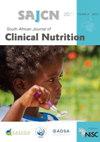南非城市妇女社会经济地位、饮食知识和模式以及身体活动与肥胖的关系
IF 0.6
Q4 NUTRITION & DIETETICS
引用次数: 3
摘要
背景:这项横断面研究考察了南非城市年轻女性的社会经济地位(SES)、饮食知识和模式、体育活动水平与体重指数之间的关系。方法:收集160名南非黑人女性(18-24岁)的数据,包括家庭社会经济地位、食物频率和营养知识问卷、自我报告的体育活动和人体测量。为了评估家庭社会经济地位指数,1-7项资产被归类为较低的家庭社会经济状况,8-13项资产被分类为较高的家庭经济状况。结构方程建模分析用于确定家庭社会经济地位、年龄、教育程度、营养知识得分、饮食模式和体育活动对肥胖的直接、间接和总体影响。结果:与低社会经济地位的同龄人相比,高社会经济地位家庭的女性超重和肥胖的患病率相似(48.4%对44.8%)。超过一半(53%)的女性饮食知识较差。与社会经济地位高的女性相比,来自社会经济地位低家庭的女性花更多的时间进行中等强度到剧烈强度的锻炼。确定了两种不同的饮食模式(西式和混合式)。SEM结果显示,与“西方”相比,坚持“混合”饮食模式的单位增加与BMI kg/m2降低0.81有关(95%CI−1.54;−0.08),而≥150 每周分钟的MVPA与1.94的低BMI kg/m2相关(95%CI−3.48;−0.41)。结论:在制定和设计旨在改善年轻女性健康的干预措施时,必须考虑SES、饮食和体育活动对BMI的影响。本文章由计算机程序翻译,如有差异,请以英文原文为准。
The relationships between socioeconomic status, dietary knowledge and patterns, and physical activity with adiposity in urban South African women
Background: This cross-sectional study examined the relationship between socioeconomic status (SES), dietary knowledge and patterns, and physical activity level with body mass index of urban South African young women. Methods: Data were collected on 160 black South African women (aged 18–24 years) and included household SES, food frequency and nutritional knowledge questionnaires, self-reported physical activity and anthropometry. To assess household SES index, 1–7 assets were categorised as a lower household SES and those with 8–13 assets as a higher household SES. Structural equation modelling analysis was used to determine the direct, indirect and total effects on adiposity of household SES, age, education, nutrition knowledge score, dietary patterns and physical activity. Results: The prevalence of overweight and obesity was similar among women from high SES households compared with their low SES peers (48.4 vs. 44.8%). More than half (53%) of the women had poor dietary knowledge. Women from low SES households spent more time in moderate to vigorous intensity exercise (MVPA) compared with their high SES counterparts. Two distinct dietary patterns (Western and mixed) were identified. SEM results show that a unit increase in adherence to the ‘Mixed’ dietary pattern compared with ‘Western’ was associated with a 0.81 lower BMI kg/m2 (95% CI −1.54; −0.08), while ≥ 150 minutes’ MVPA per week was associated with a 1.94 lower BMI kg/m2 (95% CI −3.48; −0.41). Conclusion: The associations of SES, diet and physical activity on BMI must be taken into account when developing and designing interventions that target improvement in young women’s health.
求助全文
通过发布文献求助,成功后即可免费获取论文全文。
去求助
来源期刊

South African Journal of Clinical Nutrition
NUTRITION & DIETETICS-
CiteScore
2.50
自引率
9.10%
发文量
21
期刊介绍:
1.The Journal accepts articles from all basic and applied areas of dietetics and human nutrition, including clinical nutrition, community nutrition, food science, food policy, food service management, nutrition policy and public health nutrition. 2.The Journal has a broad interpretation of the field of nutrition and recognizes that there are many factors that determine nutritional status and that need to be the subject of scientific investigation and reported in the Journal. 3.The Journal seeks to serve a broad readership and to provide information that will be useful to the scientific community, the academic community, government and non-government stakeholders in the nutrition field, policy makers and industry.
 求助内容:
求助内容: 应助结果提醒方式:
应助结果提醒方式:


